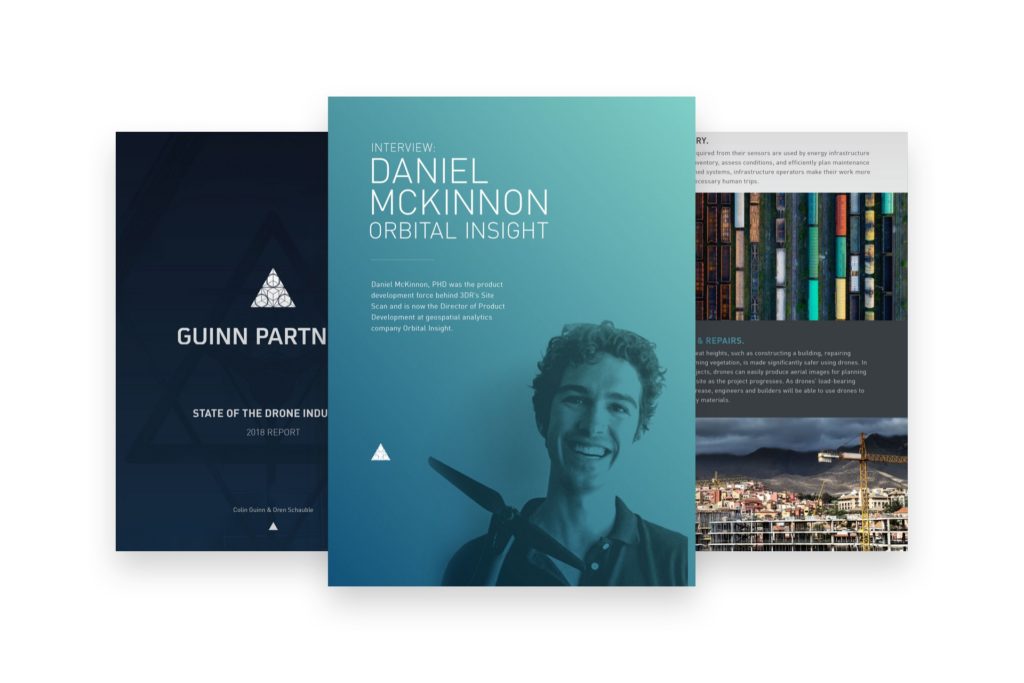My good friends from my 3DR days, Colin Guinn and Oren Schauble, just released a beautiful report on the state of the commercial drone industry. They interviewed a number of super talented friends and colleagues who are all pushing the boundaries in unmanned aviation, including Greg Crutsinger, building out a drone education platform with Scholar Farms, Kevin Finisterre, notorious for not claiming a $50k DJI bug bounty, Kevin Sartori and Lorenz Meier, commercializing PX4 with Auterion, and many others. Be sure and pick up your copy at guinnpartners.com/ebook/.

In the meantime, I reproduced my section below.
You’ve always had a great drive to talk to real users in the field and figure out just what they’re looking for and why. What do you think are some very underserved niches that could benefit from some specialized drone technology?
2) Dangerous delivery. I believe that drone delivery as a whole is largely overhyped for the immediate future, but there are certain scenarios where society spends an enormous amount of money and risks an enormous number of human lives to move a parcel from one point to another. These scenarios include mountain rescue, resupply behind enemy lines, delivery of life-saving medicines to areas stricken by disaster, and many more. We should identify situations where a human pilot is flying a multi-ton flying machine to deliver a few hundred pounds and replace that human and multi-ton flying machine with a drone.
You’ve worked on two very different sides of the aerial data industry, both in drones at Agribotix and 3DR, and in satellite imagery with Orbital Insights… What are the key differentiators between the two, why would users prefer one to the other?
While Site Scan began as a broad drone mapping platform, it evolved into a specific tool for helping engineering service providers survey their earthworks projects through relentless customer development. Nearly every business activity at 3DR from engineering backlog to customer success process was driven by 3DR users. This focus allowed 3DR to outmaneuver entrenched competitors.
You’ve hacked together some projects yourself you’ve featured on your blog and forums like DIY drones. Whats one of your favorite DIY/hacked projects you’ve done?
I love building fun software projects. I’ve done some neat things with drones including hacking together the first Solo/QX-1 prototype that later became Site Scan R10C and building a tool to check on the games at the local basketball courts. More recently, I scanned satellite imagery of the entire planet to find secret signs of civilization in remote places. That said, my current favorite is unpublished. I’ve been writing algorithms to profit from inefficiencies on and between various cryptocurrency exchanges. I’ll post this one after all of our alpha disappears.
What technology would you be excited about hearing is integrated into drones in the future?
Synthetic aperture radar. These satellites use radar to image through clouds and are not limited to day-time observation. While the resolution does not match the high bar set by E/O birds operated by companies like Digital Globe and Airbus, I am certain that the ability to image the entire earth in all conditions will unlock some new insights into the state of the planet.
What are some of the most exciting companies or technologies in GIS that you’ve come across in last year?
Orbital Insight is doing some pretty amazing work processing imagery from most of the world’s earth observation satellites into economic insights that are driving decisions across top businesses across the globe. Present company excluded, I have been most excited by the types of insights that have been extracted from voluntarily-collected phone telemetry data. I am sure that learning how the world exercises in the now-infamous Strava map and how the world travels using Uber Movement will lead to incredible changes in society itself.
If you’re new to the satellite world, whether as a new team member at a company, or a client looking into satellite data for the first time, where would you recommend learning about the industry?
The real commercial satellite industry, what many in the tech world call new space, is just lifting off (sorry, I couldn’t help myself). While Digital Globe has been selling imagery for a couple decades, their customers were largely governments and government-like organizations. Only recently have satellite imagery and analytics been available and beneficial to every business on the planet. The nascency of the industry means that information is quite fragmented. The Orbital Insight Confluence page is probably the best place on the planet to learn about satellite analytics, but if you haven’t joined our team yet, there are good webinars online hosted some of the major space hardware companies.
Anything you’d like to promote or showcase to the readers?